Don Draper of Mad Men; Leslie Knope of Parks and Recreation; Terry Thomas of Rutherford Falls: all are driven TV characters who end up as the center of gravity in whatever room they’re in. Terry, a casino CEO with big dreams played by Michael Greyeyes, is also part of a TV lineage that includes, according to Rutherford Falls cocreator and showrunner Sierra Teller Ornelas, Designing Women’s Julia Sugarbaker.
While working on the Peacock comedy’s first season, Ornelas watched Greyeyes deliver one of the character’s signature monologues that subtly paid tribute to Dixie Carter’s famously outspoken character—and, in the moment, reminded Ornelas of Barack Obama. “He had this gentle strength, but it was also layered within a sandwich of ‘don’t fuck with me’ energy,” she told Vanity Fair. “It was just the coolest thing ever.”
Greyeyes’s magnetic performance inspired Ornelas and her writers to lean even further into the model of shows like A Different World and Designing Women—ensemble comedies that regularly gave key characters meaty speeches dissecting social and cultural issues. “There would be a dense topic that they would take and analyze with comedy and humor and lightness,” observed Ornelas, who has worked on Superstore and Splitting Up Together. “I just always loved those moments, and I thought, If you could find a way to do that in the present day, wouldn’t that be so fun?”
It has been fun; part of the reason the sprightly debut season of Rutherford Falls works so well is because its core characters, no matter their histories, all care deeply about their small town, their dreams, and each other. But there’s also plenty of conflict—and all those collisions and compromises only increase in the show’s upcoming second season, according to Greyeyes. His character is often at the center of various Rutherford Falls wrangles, watching with an amused eye and never missing a thing.
“He realizes that all the things that he wants come through being observant, or more specifically, having the information necessary to make choices or to use people,” Greyeyes told Vanity Fair. “And I mean [utilizing] in the best sense: Who is he talking to? What capacities do they have, and can that person help Terry get what Terry needs or [supply] what he needs to happen for the casino or the community?… He’s only as good as the people around him, and he realizes he can’t do it alone.”
Over the course of the show’s first season, Terry mentors Reagan Wells (Jana Schmieding), who has her own big plans for preserving the heritage of the local Minishonka tribe, to which both she and Terry are devoted. Terry also manages the casino, cheers on his family members’ accomplishments, and occasionally clashes with Nathan Rutherford (Ed Helms), an enthusiastic promoter of the town named after his forebears. All the while, Terry has his eyes on an ambitious prize: a large casino-resort complex that will also feature a well-funded Minishonka museum that Reagan can run.
Getting the new casino approved and built is a big job, but no hurdle can deter, let alone defeat, Terry Thomas: He is “an immovable force,” Greyeyes said. “He is ambitious, he is powerful. His power is not a mask—it just comes from confidence.”
Greyeyes has been many things over the course of his distinguished career; a dancer, a director, a theater-company founder, a writer, and a university professor. And all of that is in addition to his impressive roster of small and large-screen credits. Not quite a year ago, Greyeyes’s leading performance in the crime thriller Wild Indian debuted to acclaim at the Sundance Film Festival, and earned him one of two Independent Spirit Award nominations (the other is for his work in Rutherford Falls). Just a few of his many other credits include the films Dance Me Outside, Woman Walks Ahead, Blood Quantum, and TV dramas like True Detective, I Know This Much Is True, and Fear the Walking Dead. (One quality that Greyeyes said he shares with his Rutherford Falls character is a tendency to be a workaholic.)
When Rutherford Falls came into his life, Greyeyes was excited, but also “low-key terrified,” in part because Terry wasn’t like anyone he had played before. “I recognized quite quickly that Sierra and the writers had created a fully empowered Indigenous man,” Greyeyes said. “I thought to myself, With Terry, I can’t use some of the old ways of working. I’ve had a wonderful career. I’ve played a lot of broken men, and there are a lot of beautiful textures in those characters. But what was interesting about Terry is that he is not broken. He’s actually whole. I had to work more quickly. And I couldn’t use any of the previous roots that I knew—what is a character’s dysfunction, where’s that from, how does that manifest itself?”
Another thing that made Rutherford Falls unusual for him is that most of the people around Greyeyes—including cocreators Ornelas, Helms, and Michael Schur, and costar Schmieding (Cheyenne River Lakota Sioux)—have long résumés in the comedy world.
“These are people with stand-up comedy chops, people with years of working in comedy,” Greyeyes said. “I was a new driver at the Indy 500. So I better get in my car and hit it hard. That’s what it felt like.”
It helped that the creative team and cast were, according to Greyeyes, generous and collaborative. It also dawned on him that he could learn from the transition of another acclaimed dramatic actor. Greyeyes is a huge fan of of Brooklyn Nine-Nine (on which Schur, Helms, and Ornelas worked), and the actor realized that as Captain Holt, Andre Braugher did not abandon the tools and skills that made him so effective in dramas like Homicide: Life on the Street and Men of a Certain Age.
“When I was watching him, I realized, Wait a second. I know what he’s doing—he’s doubling down on the things we know work in drama,” Greyeyes said. “He’s pursuing intention more vigorously. He’s pursuing his character’s goals relentlessly, and that’s why it’s funny. So I was reassured. The mechanics of scene work, they’re just starker, more elemental. I pursue the craft—I pursue what the character needs and wants—and the comedy takes care of itself.”
While it’s not difficult to find Native American characters in onscreen casinos (they’ve been part of the action in everything from Cinemax’s Banshee to the offbeat detective drama Stumptown), the leads of those projects are usually white. In the words of Greyeyes, who is Nêhiyaw from Muskeg Lake Cree Nation and who has occasionally played casino executives in the past, those kinds of characters are all too often mere “foils.” Ornelas, who is Navajo and who presides over a writing staff that has been roughly half Native both seasons, wasn’t having it: She said she was tired of the stereotype of the conniving casino Native “in a bolo tie.”
Those characters are often imbued, as Ornelas pointed out, with “greed and deviousness,” and too many of those projects don’t explore “the trauma or the tenacity and strategy that it takes to go into those spaces and lead with confidence, and to demand the things you should have,” Ornelas noted. “There is freedom in writing for Terry—he says the things that our parents and our grandparents had to sort of mutter under their breaths.”
Terry is unapologetic about his work, his accomplishments, and his ambitions—and yet it’s important to note that for him, success involves “everyone he works with moving forward,” Greyeyes said. “That includes his adversaries, it includes the whole town, certainly the entire Minishonka community, and his family and friends,” Greyeyes said.
Not surprisingly, Greyeyes has his own set of goals: As an industry veteran, he wants to build on the accomplishments of the Indigenous creatives who came before him and help break down Hollywood barriers—with “a crowbar and sledgehammer” if need be—for rising generations of storytellers from Native communities. He is writing new projects and hopes to move into the director’s chair in film and television as well.
And for Greyeyes, who recently signed an overall deal with Blumhouse, his future plans include more of the pleasure—and the relief—that comes from working on projects that have Indigenous creatives in multiple key roles.
“I’ve often said that I’ve viewed a lot of the earlier work in my career as a corrective—I looked at my role not only as an artist, but also as an educator. But I think one of the reasons why I’m achieving a certain kind of success at this moment is that I’ve been able to work with Indigenous creatives,” he noted. “When I have Indigenous creatives in decision-making roles around me, I know I can drill down on why I’m there when I’m there as an actor. I’m not there as a writer, I’m not there to fix the script or provide cultural understanding…. It’s absolutely freeing. I’ve been happy to lay that down and just really enjoy the work and the trust that’s inherent in the project.”
— The Stunning Cinematography of The Power of the Dog
— A Surreal Scene at the 2022 Golden Globe Nominations
— Who Is Leading the Best-Actress Race?
— Belfast’s Black-and-White Ode to Childhood
— The Opioid Crisis Was Everywhere on TV in 2021
— Sign up for the “Awards Insider” newsletter for must-read industry and awards coverage.

